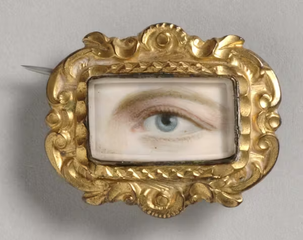Painted Eye Miniatures: Process + A Brief History
- Caitlin Velázquez-Fagley

- Sep 3
- 2 min read
I started a new project inspired by a genre of jewelry associated with the Romantic Era, called Lover's Eye jewelry. Below are images of the pair of earrings that I am working on.
I wondered how this jewelry trend came to be so I did a quick search and thought I'd share a brief historical background with you.
The first miniature eye pendant was gifted by Prince George of Wales to the woman of his dreams, Maria Anne Fitzherbert. He sent her a love letter, asking for her hand in marriage, and a painted brooch with his eye. This secret gesture instantly became a trend, and lovers (particularly from England) began commissioning paintings of their eyes to be turned into secret wearable jewelry tokens. Most pieces are hand painted with watercolor on ivory and then placed behind a piece of glass or rock crystal. The pendant or brooch was then set surrounded by gemstones, usually pearls or rubies.
Below are some of the treasures you can find at the Philadelphia Museum of Art.
While the academic discourse about why our British Victorian lovers chose the eye is centered around how a glance was a discrete yet direct method of flirtatious communication, I had to wonder if that's really why.
I had this thought because in Renaissance times, paintings of Saint Lucy were being done like this:
Above is Saint Lucy, and she is often depicted holding her own eyes.
As I found on the National Gallery of Art in Washington, DC's website:
"Multiple versions of the legend of Saint Lucy, the daughter of an aristocratic family in fourth-century Syracuse, arose during the Counter-Reformation. One popular interpretation, inspired by her unusual attribute, maintained that Lucy, determined to dedicate her life to Christ, had plucked out her eyes and sent them to a tenacious suitor after he insisted that their beauty allowed him no peace."
Is there some line of correlation here? I can't help but wonder.
I started my own miniature eye earrings by oil painting on copper. The oil on copper technique is a nod to Renaissance paintings where artists in the 1500s-1600s used copper as their canvases in some instances. They found the metal to add a 'jewel-like' quality to their paintings and found that the paints themselves acted differently from the paints on traditional canvases.
Personally, I love weaving and wondering about all these historical facets and adding them to my designs. It feels like I'm having a dialogue with artists from the past, and bringing their works to a contemporary setting.
That's all for now. Thanks so much for reading.
Take care,
Caitlin
Here is a list of the articles and websites where I found this information:
Tap on any of the paintings above to be taken to their respective websites.





















Comments